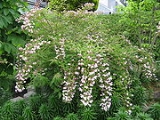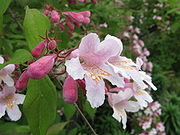
Kolkwitzia amabilis
Encyclopedia
Kolkwitzia amabilis is a species of woody flowering plant in the honeysuckle family
known in the US by the common name Beauty Bush, for amabilis, "lovely". The plant originated in Central China, where it was twice discovered, once by the Jesuit missionary Giuseppe Giraldi in Shensi and then in western Hubei province
, by E.H. 'Chinese' Wilson
who was collecting for Veitch Nurseries
, who introduced it into horticulture. It was named for Richard Kolkwitz
, a professor of botany in Berlin.
 The plant is an arching, spreading shrub, with light brown flaky bark and graceful arching branches, which can grow higher than eight feet tall. It is usually as wide as it is tall. The plant blooms in late spring. Its light pink flowers, dark pink in the bud, are about one-inch long and bell-shaped ("tubular campanulate"); they grow in pairs, as with all Caprifoliaceae
The plant is an arching, spreading shrub, with light brown flaky bark and graceful arching branches, which can grow higher than eight feet tall. It is usually as wide as it is tall. The plant blooms in late spring. Its light pink flowers, dark pink in the bud, are about one-inch long and bell-shaped ("tubular campanulate"); they grow in pairs, as with all Caprifoliaceae
, and form showy, numerous sprays along ripened wood. Its leaves are opposite, simple, and ovate, from .5 to 3 inches long, entire or with a few sparse shallow teeth. Its fruit is a hairy, ovoid capsule approximately .25 inches long.
Wilson sent plant material to his sponsors Veitch Nurseries
, Exeter, in 1901; the shrub flowered there for the first time in 1910. It received a Royal Horticultural Society
Award of Merit in 1923 for Nymans Gardens, Sussex
. The shrub became very popular in the eastern United States following World War I, almost a defining shrub in American gardens made between the World Wars.
In the garden, the shrub needs plenty of room to develop its long, arching sprays, reducing the temptation to club it back, which results in an unnatural "witches' broom". Occasionally older stems thicker than a broomstick should be removed at the base when the shrub is dormant, to encourage young, free-flowering growth.
Caprifoliaceae
The Caprifoliaceae or honeysuckle family is a clade consisting of about 800 dicotyledonous flowering plants, with a nearly cosmopolitan distribution; centres of diversity are found in eastern North America and eastern Asia, while they are absent in tropical and southern Africa.They are mostly...
known in the US by the common name Beauty Bush, for amabilis, "lovely". The plant originated in Central China, where it was twice discovered, once by the Jesuit missionary Giuseppe Giraldi in Shensi and then in western Hubei province
Hubei
' Hupeh) is a province in Central China. The name of the province means "north of the lake", referring to its position north of Lake Dongting...
, by E.H. 'Chinese' Wilson
Ernest Henry Wilson
Ernest Henry "Chinese" Wilson , better known as E. H. Wilson, was a notable English plant collector who introduced a large range of about 2000 of Asian plant species to the West; some sixty bear his name.-Career:...
who was collecting for Veitch Nurseries
Veitch Nurseries
The Veitch Nurseries were the largest group of family-run plant nurseries in Europe during the 19th century. Started by John Veitch sometime before 1808, the original nursery grew substantially over several decades and was eventually split into two separate businesses - based at Chelsea and...
, who introduced it into horticulture. It was named for Richard Kolkwitz
Richard Kolkwitz
Richard Kolkwitz was a German botanist who was a native of Berlin. He studied natural sciences at the University of Berlin under Adolf Engler and Simon Schwendener , and from 1895 to 1900 was an assistant at the university under Leopold Kny...
, a professor of botany in Berlin.

Caprifoliaceae
The Caprifoliaceae or honeysuckle family is a clade consisting of about 800 dicotyledonous flowering plants, with a nearly cosmopolitan distribution; centres of diversity are found in eastern North America and eastern Asia, while they are absent in tropical and southern Africa.They are mostly...
, and form showy, numerous sprays along ripened wood. Its leaves are opposite, simple, and ovate, from .5 to 3 inches long, entire or with a few sparse shallow teeth. Its fruit is a hairy, ovoid capsule approximately .25 inches long.
Wilson sent plant material to his sponsors Veitch Nurseries
Veitch Nurseries
The Veitch Nurseries were the largest group of family-run plant nurseries in Europe during the 19th century. Started by John Veitch sometime before 1808, the original nursery grew substantially over several decades and was eventually split into two separate businesses - based at Chelsea and...
, Exeter, in 1901; the shrub flowered there for the first time in 1910. It received a Royal Horticultural Society
Royal Horticultural Society
The Royal Horticultural Society was founded in 1804 in London, England as the Horticultural Society of London, and gained its present name in a Royal Charter granted in 1861 by Prince Albert...
Award of Merit in 1923 for Nymans Gardens, Sussex
Nymans
Nymans, Handcross, Haywards Heath, West Sussex, is an English garden developed by three generations of the Messel family, from the late 19th century, and brought to renown by Col. Leonard C.R. Messel...
. The shrub became very popular in the eastern United States following World War I, almost a defining shrub in American gardens made between the World Wars.
In the garden, the shrub needs plenty of room to develop its long, arching sprays, reducing the temptation to club it back, which results in an unnatural "witches' broom". Occasionally older stems thicker than a broomstick should be removed at the base when the shrub is dormant, to encourage young, free-flowering growth.

